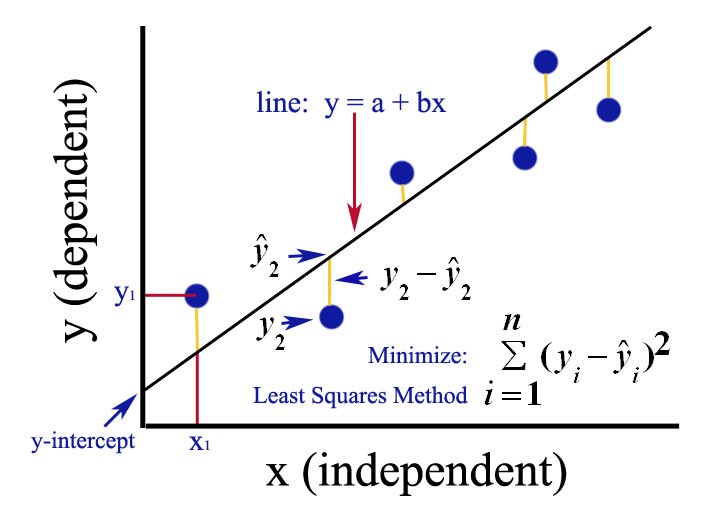Regression is a statistical tool for investigating the relationships between variables. Simple linear regression is the simplest form of regression; it creates a linear model for the relationship between the dependent variable and a single independent variable. Visually, simple linear regression "draws" a trend line on the scatter plot of two variables that best approximates their linear relationship. The model can be expressed with the two parameters of its line: slope and intercept. Other models use more parameters for more complex curves. This is one of the most popular tools in statistics, and it is frequently used as a predictor for machine learning.
Explanation and history
At the core of linear regression is the method of least squares. In this method, the linear trend line is chosen which minimizes the sum of every data point’s squared residual (deviation from the model).
The method of least squares was independently discovered by Carl Friedrich-Gauss and Adrien-Marie Legendre in the early 19th century. The linear regression methods used today can be primarily attributed to the work of R.A. Fisher in the 1920s.
Use-cases
In simple linear regression, both the independent and dependent variables must be numeric. The dependent variable (y) can then be expressed in terms of the independent variable (x) using the two line parameters intercept (a) and slope (b) with the equation y = a + b * x. For these approximations to be meaningful, the dependent variable should take continuous values. The relationship between any two variables satisfying these conditions can be analyzed with simple linear regression. However, the model will only be successful for linearly related data. Some common examples include:
-
Predicting housing prices with square footage, number of bedrooms, number of bathrooms, etc.
-
Analyzing sales of a product using pricing or performance information
-
Calculating causal relationships between parameters in biological systems
Constraints
Because simple linear regression is so straightforward, it can be used with any numeric data pair. The real question is how well the best model fits the data. There are several measurements which attempt to quantify the success of the model. For example, the coefficient of determination (r2) is the proportion of the variance in the dependent variable that is predictable from the independent variable. A coefficient r2 = 1 indicates that the variance in the dependent variable is entirely predictable from the independent variable (and thus the model is perfect).

Example
Let’s look at a straightforward example—predicting short term rental listing prices using the listing’s number of bedrooms. Run :play http://guides.neo4j.com/listings and follow the import statements to load Will Lyon’s rental listing graph.
CALL regression.linear.create('airbnb prices')MATCH (list:Listing)-[n:IN_NEIGHBORHOOD]->(hood:Neighborhood {neighborhood_id:'78704'})
WHERE exists(list.bedrooms)
AND exists(list.price)
AND NOT list:Trained
CALL regression.linear.add('airbnb prices', [list.bedrooms], list.price)
SET list:Trained
RETURN *RETURN regression.linear.predict('airbnb prices', [4])MATCH (list:Listing)-[:IN_NEIGHBORHOOD]->(:Neighborhood {neighborhood_id:'78704'})
WHERE exists(list.bedrooms) AND NOT exists(list.price)
SET list.predicted_price = regression.linear.predict('airbnb prices', [list.bedrooms])MATCH (list:Listing {listing_id:'2467149'})-[:IN_NEIGHBORHOOD]->(:Neighborhood {neighborhood_id:'78704'})
CALL regression.linear.remove('airbnb prices', [list.bedrooms], list.price)
REMOVE list:TrainedMATCH (list:Listing)-[:IN_NEIGHBORHOOD]->(:Neighborhood {neighborhood_id:'78701'})
WHERE exists(list.bedrooms)
AND exists(list.price)
AND NOT list:Trained
CALL regression.linear.add('airbnb prices', [list.bedrooms], list.price)
SET list:Trained RETURN listCALL regression.linear.info('airbnb prices')
YIELD model, framework, hasConstant, numVars, state, N, infoMERGE (m:ModelNode {model: 'airbnb prices'})
SET m.data = regression.linear.data('airbnb prices')CALL regression.linear.delete('airbnb prices')
YIELD model, framework, hasConstant, numVars, state, N, infoMATCH (m:ModelNode {model: 'airbnb prices'})
CALL regression.linear.load('airbnb prices', m.data)
YIELD model, framework, hasConstant, numVars, state, N, info
RETURN model, framework, hasConstant, numVars, state, N, infoNow the model is ready for further data changes and predictions!
Syntax
The simple linear regression procedures were created so that the same procedures may be used for multiple linear regression. Therefore, independent variable must be specified [in brackets] and you must specify number of variables (1) at time of creation as well as the type of model you would like to create ("Simple").
If your queries return duplicate values (eg: both directions of the same relationship) then data from the same observation may be added to the model multiple times. This will make your model less accurate. It is recommended that you be careful with queries (eg: specify direction of relationship) or store somewhere in relevant nodes/relationships whether this data has been added to the model. This way you can be sure to select relevant data points which have not yet been added to the model.
